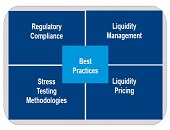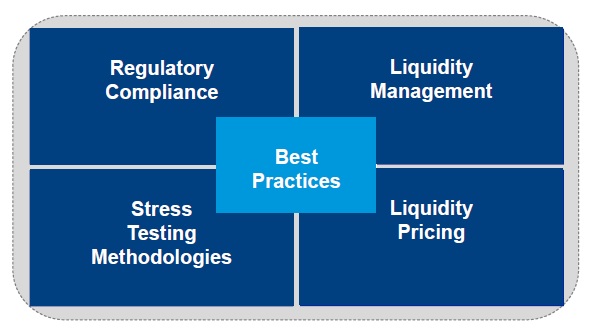Are you scrambling to adjust to new reporting expectations for liquidity risk? Getting good data is key, but “you have to get it right and on time,” said Pierre Mesnard, Director Solutions Specialist at Moody’s Analytics. He was the third of three presenters on liquidity risk compliance at a webinar on June 25, 2015, sponsored by the Global Association of Risk Professionals.
Once you have the data, there are three steps to delivering integrated liquidity compliance and business management, said Mesnard. First, you must ensure all financial instruments at your bank can be adequately modelled in order to generate realistic cash flow. This includes off-balance sheet commitments, derivatives, and illiquid assets.
Second, you must implement the compliance rules and the internal liquidity policy in the system where you are modelling the cash flows. He noted the system should contain regulatory inputs and have the flexibility to allow for changes in behavioural assumptions such as prepayments.
Third, the reporting must disclose everything the regulator wants, such as liquidity compliance ratio (LCR) and net stable funding ratio (NSFR) as well as the asset- liability maturity mismatch (ALMM). The reporting will have special aggregation rules for combining quantities.
Mesnard described a Unified Data Platform (UDP), which would load highly granular data and run necessary checks. He recommended the automation of tasks such as data reconciliation, in order to make the process faster. “We need smart rules in data cleansing.”
The UDP would mix risk and financial information, and permit consolidation of the entire balance sheet. There would be a “central repository to simplify all adjustments processes,” he noted. This would give a harmonized view of liquidity indicators.
The accompanying figure summarizes best practices and what would be available through the UDP. “It should go beyond compliance,” he emphasized. Each bank can set up its own, proper liquidity management. “The rules such as for asset categories have changed a lot in recent years, so the rules in the UDP must be editable, in case they change again.”
“Regulatory indicators will be used to complement internal liquidity metrics,” he noted. For example, the LCR forecast is now a standard ratio to be found on risk dashboards. ª
Click here to view the webinar presentation. Mesnard’s portion is from slides 26 to 31.
Click here to read about the first presentation.
Click here to read about the second presentation.
Figure 1 is used with permission from the presentation by Pierre Mesnard.


